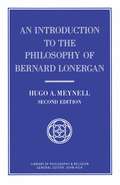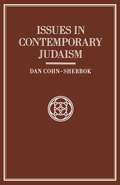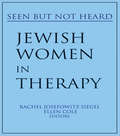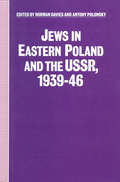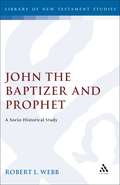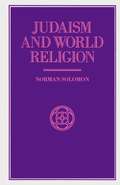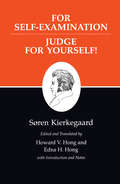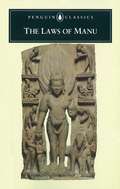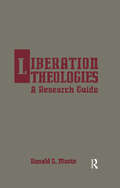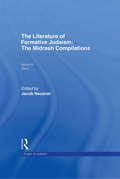- Table View
- List View
An Introduction to Buddhist Psychology (Library of Philosophy and Religion)
by Padmasiri De SilvaAn introduction to the foundations of Buddhist psychology, this book deals with the nature of psychological inquiry, concepts of mind, conciousness and behaviour, emotions and personality, motivation and the therapeutic structures of Buddhist psychology.
An Introduction to the Philosophy of Bernard Lonergan (Library Of Philosophy And Religion Ser.)
by Hugo A. MeynellThis is an introduction to the philosophy of a Christian thinker of the 20th century. The author pursues his thesis through mathematics, empirical science, common sense, depth psychology and social theory, into metaphysics, ethics and natural theology.
Iran At The Crossroads: Global Relations In A Turbulent Decade
by Miron RezunThe chapters in this book were written by me or solicited from renowned experts to produce a work that anticipated an imminent post- Khomeini period in Iranian history. The first draft was not ready until June 1989, practically coinciding with the death of Khomeini and the tenth anniversary of the Iranian Revolution-an important milestone after a decade of turmoil. The book you are about to read took some time to put together. Based on extensive research, the project was undertaken in early 1988 and ended about the spring of 1990. A sincere debt of gratitude is naturally owed to all of my contributors. But the preparation of any book does not take place in a financial void. My gratitude is especially extended to the academic vice-president of my university, Dr. Robert Burridge, for granting me the seed money from the university's Development Fund. Substantial financial assistance to cover the bulk of the logistical expenses was offered by the Canadian Institute of International Peace and Security in Ottawa and by the Social Sciences and Humanities Research Council of Canada through its program of aid to scholarly conferences.
Iran At The Crossroads: Global Relations In A Turbulent Decade
by Miron RezunThe chapters in this book were written by me or solicited from renowned experts to produce a work that anticipated an imminent post- Khomeini period in Iranian history. The first draft was not ready until June 1989, practically coinciding with the death of Khomeini and the tenth anniversary of the Iranian Revolution-an important milestone after a decade of turmoil. The book you are about to read took some time to put together. Based on extensive research, the project was undertaken in early 1988 and ended about the spring of 1990. A sincere debt of gratitude is naturally owed to all of my contributors. But the preparation of any book does not take place in a financial void. My gratitude is especially extended to the academic vice-president of my university, Dr. Robert Burridge, for granting me the seed money from the university's Development Fund. Substantial financial assistance to cover the bulk of the logistical expenses was offered by the Canadian Institute of International Peace and Security in Ottawa and by the Social Sciences and Humanities Research Council of Canada through its program of aid to scholarly conferences.
Jesus and the Oral Gospel Tradition (The Library of New Testament Studies #64)
by Henry WansboroughA collection of papers from two international symposia by such important scholars as Aune, Dunn, Gerhardsson, Meyer, Rordorf and Talmon. The articles share the conviction that the only way to break the deadlock in the Synoptic problem is to examine the oral tradition about Jesus which lay behind the Gospels, and to continue even beyond them. The book addresses such central issues as the characteristics of oral tradition: oral tradition in Judaism, in the teaching of Jesus (his aphorisms and the narrative meshalim) and in the Gospel narratives; and the relationships of John, Paul and the Didache to oral tradition. This volume should bring onto a new plane the discussion of the all-important oral stage of Gospel tradition.
Jewish Women in Therapy: Seen But Not Heard
by Rachel J Siegel Ellen ColeHere is the first volume ever to focus on the issues of Jewish women in the context of counseling and psychotherapy. Through poignant reflection and observation, the authors convey the richness and variety of Jewish women’s experiences and the Jewishness and femaleness of the concerns, issues, values, and attitudes that Jewish women--both clients and therapists--bring into the therapy room.Jewish Women in Therapy is a landmark book in many ways. It calls attention to the historical and political realities of the Jewish heritage and acknowledges the oppression of both Jews and women that therapists have typically ignored. And although Jewish women have participated in the therapeutic process, as clients, scholars, and therapists, seldom have they chosen to write about it.Never before have the writings of so many distinguished leaders in the field, including Melanie Kaye/Kantrowitz, Evelyn Torton Beck, and Susannah Heschel, been compiled. They examine the damaging stereotypes of Jewish women--the Jewish American Princess and the Jewish Mother--that flourish today. Chapters also address the conflicts that many women feel about being Jewish and being female, celebrate the contributions of Jewish women to feminism and to therapy, examine the deliberate omission of women from the political process and the religious ritual, and convey the complexities of the oppression that are still blatantly directed at both Jews and females.
Jewish Women in Therapy: Seen But Not Heard
by Rachel J Siegel Ellen ColeHere is the first volume ever to focus on the issues of Jewish women in the context of counseling and psychotherapy. Through poignant reflection and observation, the authors convey the richness and variety of Jewish women’s experiences and the Jewishness and femaleness of the concerns, issues, values, and attitudes that Jewish women--both clients and therapists--bring into the therapy room.Jewish Women in Therapy is a landmark book in many ways. It calls attention to the historical and political realities of the Jewish heritage and acknowledges the oppression of both Jews and women that therapists have typically ignored. And although Jewish women have participated in the therapeutic process, as clients, scholars, and therapists, seldom have they chosen to write about it.Never before have the writings of so many distinguished leaders in the field, including Melanie Kaye/Kantrowitz, Evelyn Torton Beck, and Susannah Heschel, been compiled. They examine the damaging stereotypes of Jewish women--the Jewish American Princess and the Jewish Mother--that flourish today. Chapters also address the conflicts that many women feel about being Jewish and being female, celebrate the contributions of Jewish women to feminism and to therapy, examine the deliberate omission of women from the political process and the religious ritual, and convey the complexities of the oppression that are still blatantly directed at both Jews and females.
Jews in Eastern Poland and the USSR, 1939-46 (Studies in Russia and East Europe)
by Norman Davies Antony PolonskyThis book is the first to deal with the impact on the Jews of the area of the sovietization of Eastern Poland. Polish resentment at alleged Jewish collaboration with the Soviets between 1939 and 1941 affected the development of Polish-Jewish relations under Nazi rule and in the USSR. The role of these conflicts both in the Anders army and in the Communist-led Kosciuszko division and 1st Polish Army is investigated, as well as the part played by Jews in the communist-dominated regime in Poland after 1944.
The Jews of the Ottoman Empire and the Turkish Republic
by Stanford J. ShawThis book studies the role of the Ottoman Empire and Republic of Turkey in providing refuge and prosperity for Jews fleeing from persecution in Europe and Byzantium in medieval times and from Russian pogroms and the Nazi holocaust in the nineteenth and twentieth centuries. It studies the religiously-based communities of Ottoman and Turkish Jews as well as their economic, cultural and religious lives and their relations with the Muslims and Christians among whom they lived.
John the Baptizer and Prophet: A Socio-Historical Study (The Library of New Testament Studies #62)
by Robert L. WebbUsing recent methodological advances in historical Jesus research, this book examines the figure of John by focusing on the two characteristic roles which he publicly performed-baptizer and prophet. The significance of these roles is studied within the context of late Second Temple Judaism in order to understand John within his social and historical context. Part I examines the traditions concerning John in Josephus's Antiquities as well as in canonical and extra canonical Gospels. Part II studies John's role as baptizer by analysing the functions of ablutions in the Old Testament and Second Temple Jewish literature, especially the Qumran literature. Part III analyses John's public role of prophet. John is seen as the leader of a prophetic movement, whose sociopolitical orientation may be compared with similar movements of the period.
Judaism and World Religion (Library of Philosophy and Religion)
by Norman SolomonA text which draws on traditional sources, mainly but not exclusively Jewish, to address contemporary issues, ranging from conservation of the environment, through to business and commercial ethics, to relations between State and religion.
Judaism, Christianity, and Islam: From Convenant to Community
by F. E. PetersInvoking a concept as simple as it is brilliant, F. E. Peters has taken the basic texts of the three related--and competitive--religious systems we call Judaism, Christianity, and Islam and has juxtaposed them in a topical and parallel arrangement according to the issues that most concerned all these "children of Abraham." Through these extensive passages, and the author's skillful connective commentary, the three traditions are shown with their similarities sometimes startlingly underlined and their well-known differences now more profoundly exposed. What emerges from this unique and ambitious work is a panorama of belief, practice, and sensibility that will broaden our understanding of our religious and political roots in a past that is, by these communities' definition, still the present. The hardcover edition of the work is bound in one volume, and in the paperback version the identical material is broken down into three smaller but self-contained books. The first, "From Covenant to Community," includes texts and comments on the covenant and early history of the Chosen People and their post-Exilic reconstruction; the career and message of the Messiah Jesus and the Prophet Muhammad; the concept of holiness and of a "kingdom of priests"; and, finally, the notions of church and state and the state as a church. Throughout the work we hear an amazing variety of voices, some familiar, some not, all of them central to the primary and secondary canons of their own tradition: alongside the Scriptural voice of God are the words of theologians, priests, visionaries, lawyers, rulers and the ruled. The work ends, as does the same author's now classic Children of Abraham, in what Peters calls the "classical period," that is, before the great movements of modernism and reform that were to transform Judaism, Christianity, and Islam.
Judaism, Christianity, and Islam: From Convenant to Community
by F. E. PetersInvoking a concept as simple as it is brilliant, F. E. Peters has taken the basic texts of the three related--and competitive--religious systems we call Judaism, Christianity, and Islam and has juxtaposed them in a topical and parallel arrangement according to the issues that most concerned all these "children of Abraham." Through these extensive passages, and the author's skillful connective commentary, the three traditions are shown with their similarities sometimes startlingly underlined and their well-known differences now more profoundly exposed. What emerges from this unique and ambitious work is a panorama of belief, practice, and sensibility that will broaden our understanding of our religious and political roots in a past that is, by these communities' definition, still the present. The hardcover edition of the work is bound in one volume, and in the paperback version the identical material is broken down into three smaller but self-contained books. The first, "From Covenant to Community," includes texts and comments on the covenant and early history of the Chosen People and their post-Exilic reconstruction; the career and message of the Messiah Jesus and the Prophet Muhammad; the concept of holiness and of a "kingdom of priests"; and, finally, the notions of church and state and the state as a church. Throughout the work we hear an amazing variety of voices, some familiar, some not, all of them central to the primary and secondary canons of their own tradition: alongside the Scriptural voice of God are the words of theologians, priests, visionaries, lawyers, rulers and the ruled. The work ends, as does the same author's now classic Children of Abraham, in what Peters calls the "classical period," that is, before the great movements of modernism and reform that were to transform Judaism, Christianity, and Islam.
Kierkegaard's Writings, XXI, Volume 21: For Self-Examination / Judge For Yourself!
by Søren Kierkegaard Howard V. Hong Edna H. HongFor Self-Examination and its companion piece Judge for Yourself! are the culmination of Søren Kierkegaard's "second authorship," which followed his Concluding Unscientific Postscript. Among the simplest and most readily comprehended of Kierkegaard's books, the two works are part of the signed direct communications, as distinguished from his earlier pseudonymous writings. The lucidity and pithiness, and the earnestness and power, of For Self-Examination and Judge for Yourself! are enhanced when, as Kierkegaard requested, they are read aloud. They contain the well-known passages on Socrates' defense speech, how to read, the lover's letter, the royal coachman and the carriage team, and the painter's relation to his painting. The aim of awakening and inward deepening is signaled by the opening section on Socrates in For Self-Examination and is pursued in the context of the relations of Christian ideality, grace, and response. The secondary aim, a critique of the established order, links the works to the final polemical writings that appear later after a four-year period of silence.
Kierkegaard's Writings, XXI, Volume 21: For Self-Examination / Judge For Yourself!
by Søren Kierkegaard Howard V. Hong Edna H. HongFor Self-Examination and its companion piece Judge for Yourself! are the culmination of Søren Kierkegaard's "second authorship," which followed his Concluding Unscientific Postscript. Among the simplest and most readily comprehended of Kierkegaard's books, the two works are part of the signed direct communications, as distinguished from his earlier pseudonymous writings. The lucidity and pithiness, and the earnestness and power, of For Self-Examination and Judge for Yourself! are enhanced when, as Kierkegaard requested, they are read aloud. They contain the well-known passages on Socrates' defense speech, how to read, the lover's letter, the royal coachman and the carriage team, and the painter's relation to his painting. The aim of awakening and inward deepening is signaled by the opening section on Socrates in For Self-Examination and is pursued in the context of the relations of Christian ideality, grace, and response. The secondary aim, a critique of the established order, links the works to the final polemical writings that appear later after a four-year period of silence.
Law and Ideology in Monarchic Israel (The Library of Hebrew Bible/Old Testament Studies)
by Baruch Halpern Deborah W. HobsonThree major essays by Baruch Halpern, Brian Peckham and Paul E. Dion deal with traumatic changes in Israelite culture, in particular the transition from the traditional culture of Israel in Iron Age IIA (tenth-ninth centuries) to a new, more widely literate culture in the eighth-seventh centuries BCE. These essays throw into relief changes in legal, political and religious culture in Judah in the last 150 years of its independence. Their combined implications for the origins of Western law and civilization, and for the models from which Reformation and Enlightenment political theory were drawn, are substantial.
The Laws of Manu (Penguin Classics Series)
by Wendy Doniger Brian SmithThe Laws of Manu form a towering work of Hindu philosophy. Composed by many Brahmin priests, this is an extraordinary, encyclopaedic representation of human life in the world, and how it should be lived. Manu encompasses topics as wide-ranging as the social obligations and duties of the various castes, the proper way for a righteous king to rule and to punish transgressors, relations between men and women, birth, death, taxes, karma, rebirth and ritual practices. First translated into English in 1794, its influence spread from Nietzsche to the British Raj, and although often misinterpreted, it remains an essential work for understanding India today.
Liberation Theologies: A Research Guide
by Ronald G. MustoFirst Published in 1991. The following is a comprehensive scholarly bibliography of published materials on the varieties of liberation theology, mostly in book form, available in English. It is intended as an introductory survey to this vast and quickly expanding field for the teacher and student of contemporary theology, of biblical hermeneutics, and to the interrelationship of politics and religion around the world. It will also serve as a comprehensive bibliography.
Liberation Theologies: A Research Guide
by Ronald G. MustoFirst Published in 1991. The following is a comprehensive scholarly bibliography of published materials on the varieties of liberation theology, mostly in book form, available in English. It is intended as an introductory survey to this vast and quickly expanding field for the teacher and student of contemporary theology, of biblical hermeneutics, and to the interrelationship of politics and religion around the world. It will also serve as a comprehensive bibliography.
The Life and Death Debate: Moral Issues of Our Time
by Norman L. Geisler J MorelandThis work is an introductory treatment of issues and options in social and bioethics which center on the end of life. Moreland and Geisler have attempted to simplify and summarize various end-of-life topics without being simplistic or caricaturing different viewpoints, even though the authors' own viewpoints are made perfectly clear. A comprehensive bibliography, glossary, and subject and author index make this a valuable textbook as well as a resource for further study.The major purpose of this book is to make the reader think more clearly and deeply about the important issues discussed between its covers. Beginning the work is an essay that introduces the dilemma of ethical decisions. The following chapters separately discuss the situations of abortion, infanticide, euthanasia, suicide, capital punishment, and war. The discussion concludes with a chapter of practical and theoretical guidance for making ethical decisions. A glossary, subject index, author index, and selected bibliography for each chapter make this a valuable text. This important work will not only appeal to experienced philosophers, but also to students of moral philosophy, theology, and ethics.
Life of St Columba
by Adomnan Of Iona Richard SharpeFounding father of the famous monastery on the island of Iona, a site of pilgrimage ever since his death in 597, St Columba was born into one of the ruling families in Ireland at a time of immense expansion for the Irish Church. This account of his life, written by Adomnán - the ninth abbot of Iona, and a distant relative of St Columba - describes his travels from Ireland to Scotland and his mission in the cause of Celtic Christianity there. Written 100 years after St Columba's death, it draws on written and oral traditions to depict a wise abbot among his monks, who like Christ was capable of turning water into wine, controlling sea-storms and raising the dead. An engaging account of one of the central figures in the 'Age of Saints', this is a major work of early Irish and Scottish history.
The Literature of Formative Judaism: The Midrash Compilations
by Jacob NeusnerFirst published in 1991. Routledge is an imprint of Taylor & Francis, an informa company.
The Literature of Formative Judaism: The Midrash Compilations (The\origins Of Judaism Ser. #Vol. 11)
by Jacob NeusnerFirst published in 1991. Routledge is an imprint of Taylor & Francis, an informa company.

